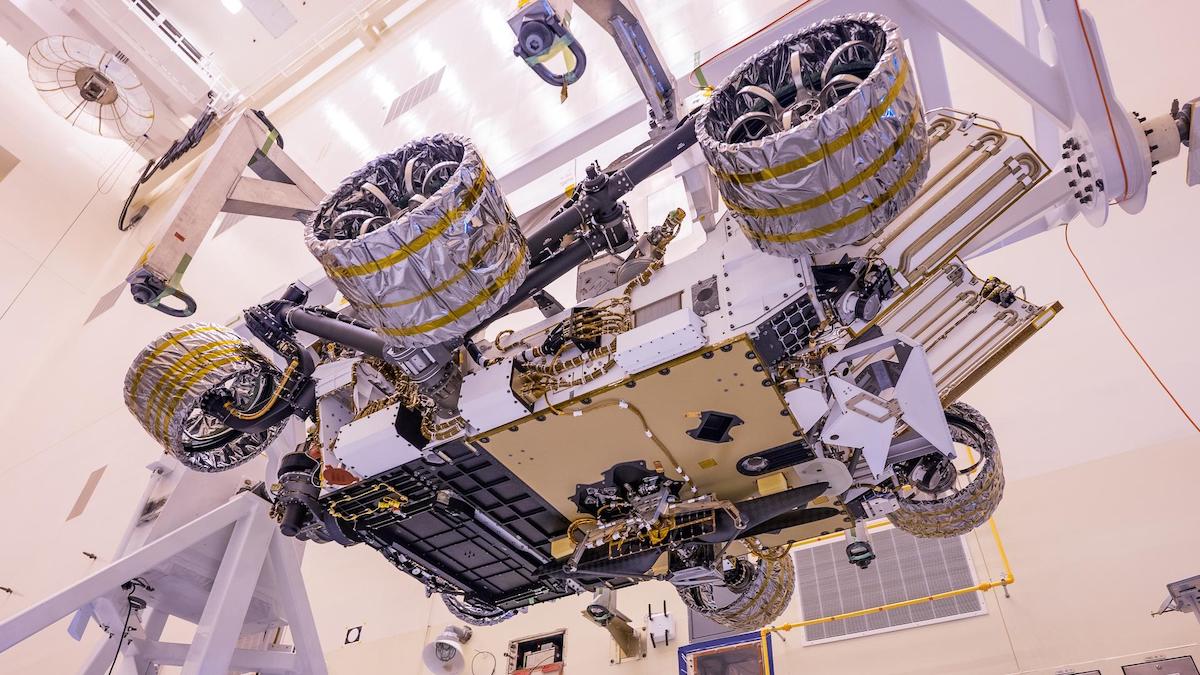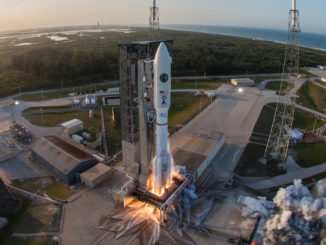
Working under the cloud of the global coronavirus pandemic, technicians and engineers at NASA’s Kennedy Space Center have installed a rotor-driven drone on the agency’s next Mars rover and fueled the spacecraft’s “sky crane” landing system in preparation for launch in July.
The Mars Helicopter was attached to the belly of the Perseverance rover April 6 inside the Payload Hazardous Servicing Facility at Kennedy. The rotorcraft will become the first vehicle of its kind to fly to another planet.
The flying drone was added to the Perseverance rover as a technology demonstration payload. It weighs around 4 pounds (1.8 kilograms) stands around 2.6 feet (80 centimeters) tall when fully deployed, and has twin counter-rotating rotors that span around 4 feet (1.2 meters) tip-to-tip, according to NASA.
During the trip to Mars, the helicopter will be housed inside a delivery system on the bottom of the rover. It will remain in that position for more than a year from the time it was installed earlier this month.
The Mars Perseverance rover is scheduled to land in Jezero Crater, the site of an ancient dried-up Martian river delta, on Feb. 18, 2021. Deployment of the Mars Helicopter is planned in early May 2021, NASA said.
The helicopter was first attached to the rover at NASA’s Jet Propulsion Laboratory for testing last year.
On April 6, technicians working inside a pristine clean room at the Kennedy Space Center made 34 electrical connections between the rover, the helicopter and its delivery system on the belly of the rover, according to NASA.
“After confirming data and commands could be sent and received, they attached the delivery system to the rover,” NASA said in a press release. “Finally, the team confirmed the helicopter could receive an electrical charge from the rover. Before being deployed onto the surface of Jezero Crater, the Mars Helicopter will rely on the rover for power.”
Once deployed on the surface of Mars, the helicopter will generate electricity with its own solar panel. The rover will release the drone onto the ground and drive away to a distance of at least 330 feet (100 meters) before the helicopter flies for the first time.
Ground controllers will program the helicopter to perform a series of test flights during a planned 30-day campaign.
The helicopter will fly autonomously, without real-time input from ground controllers millions of miles away. The drone carries two cameras, and telemetry from the helicopter will be routed through a base station on the rover.

The atmosphere at the Martian surface is about 1 percent the density of Earth’s, limiting the performance of a rotorcraft like the Mars Helicopter.
The rotors on the Mars Helicopter will spin between 2,400 and 2,900 rpm, about 10 times faster than a helicopter flying in Earth’s atmosphere. The altitude record for a helicopter on Earth is around 40,000 feet.
Future rotorcraft could be dispatched to other planets with more sophisticated scientific instruments.
NASA has selected a robotic mission named Dragonfly to explore Saturn’s largest moon Titan. But Titan has a much thicker atmosphere than Mars, which eases the difficulty of rotor-driven flight.
Another pre-launch milestone achieved earlier this month was the fueling of the Perseverance rover’s sky crane landing system, which will deliver the robot to the surface of Mars. The sky crane system was first used during the landing of NASA’s Curiosity rover in 2012, and uses rocket thrusters to slow to a hover over the Martian surface, then lowers the rover to the ground on Nylon cords.
Once the rover is on the surface, the sky crane cuts the bridles and flies a safe distance away.
The sky crane and rover will enter the Martian atmosphere inside a heat shield, which will deploy a supersonic parachute for the initial phase of braking. Then the sky crane and rover will separate from the entry shell to perform the final landing maneuvers.
In early April, technicians inside the rover processing facility at Kennedy loaded 884 pounds (401 kilograms) of hydrazine monopropellant into the sky crane’s four fuel tanks. The hydrazine propellant will feed the sky crane’s eight Mars landing rocket engines.
“The last hundred days before any Mars launch is chock-full of significant milestones,” said David Gruel, the Mars 2020 assembly, test and launch operations manager at NASA’s Jet Propulsion Laboratory. “Fueling the descent stage is a big step. While we will continue to test and evaluate its performance as we move forward with launch preparations, it is now ready to fulfill its mission of placing Perseverance on the surface on Mars.”
Preparations for the Perseverance rover launch are continuing amid the coronavirus pandemic. NASA has deemed the Mars rover as a top priority because if the mission misses a launch opportunity this year, the next chance to send the rover to Mars will not be until the second half of 2022.
The launch period opens July 17 and extends through Aug. 5. The launch window July 17 opens around 9 a.m. EDT (1300 GMT).
The rover will depart Earth aboard a United Launch Alliance Atlas 5 rocket.
Last month, NASA announced the name Perseverance for the next Mars rover after soliciting ideas from school children in a national essay-writing contest. The mission was previously known as Mars 2020.

The Perseverance rover, its cruise stage, sky crane descent stage and the Mars Helicopter arrived Feb. 12 at the Kennedy Space Center on a pair of U.S. Air Force cargo planes from California, where the hardware as assembled at the Jet Propulsion Laboratory.
After shipment to Kennedy, the hardware was unpacked inside the Payload Hazardous Servicing Facility, or PHSF. Ground teams installed the rover’s sample collection system in March.
The rover’s sampling hardware, called the Adaptive Caching Assembly, is one of the most complex devices ever sent to Mars. NASA says it consists of seven motors and more than 3,000 parts, plus a sample handling arm to move sample tubes to the main robotic arm’s coring drill, then transfer the filled tubes to be sealed and stored.
Technicians also integrated the rover’s Bit Carousel, which carries nine drill bits the rover will use to sample Martian rocks and dust.
The rock specimens collected by the Perseverance rover will be picked up by a future robotic mission to return the samples to Earth for detailed analysis. Scientists hope to find evidence of ancient life.
Perseverance also has a suite of scientific instruments and a zoom-capable camera to survey the Martian surface, gathering information on soil and rock composition, and the presence of organic material, the building blocks of life. A Norwegian-developed ground-penetrating radar on Perseverance will study the Red Planet’s underground geologic structure.
The instruments mounted inside the Perseverance rover’s main body include MOXIE, which will demonstrate the production of oxygen from carbon dioxide in the atmosphere of Mars, a capability that future astronaut explorers could use.
The mission also carries a weather station and two microphones to record the sound of the rover’s landing and Martian winds.
Technicians fitted the rover’s six flight wheels March 30, replacing spares that were used during the craft’s earlier testing. The aluminum wheels feature titanium spokes, and are slightly narrower, thicker and larger in diameter than the wheels on the Curiosity Mars rover.
Engineers also designed the Perseverance wheels with a new tread. The changes are intended to make the wheels better equipped to withstand sharp rocks, which have damaged Curiosity’s wheels on Mars.
The Perseverance ground team also added the mission’s supersonic parachute March 26.
Other items remaining to be installed on the rover include the sampling tubes that will be used to store rock and dust specimens gathered by Perseverance.
The rover will be mated to the sky crane descent stage and cocooned inside the mission’s heat shield in the coming months, then connected to the cruise stage, which will ferry the craft on the interplanetary journey to Mars.
The fully-integrated spacecraft will be encapsulated inside the payload fairing of ULA’s Atlas 5 rocket, then moved to the Atlas 5’s vertical hangar at Cape Canaveral for stacking atop the launcher. Once the rover is on top of the rocket, teams will install Perseverance’s nuclear battery.
Email the author.
Follow Stephen Clark on Twitter: @StephenClark1.



